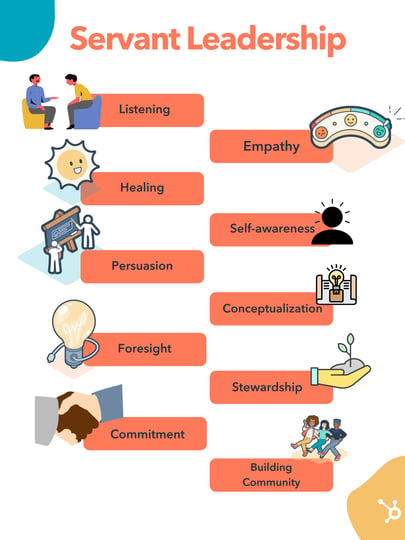Leadership looks different for everyone.
Some choose to use a democratic style, where they make final decisions after getting input from team members. Some are individualists, focused on personal development and improvement, while others act as a coach that works to help employees develop their skills and build strong teams.
Although different in practice, most leadership styles have in common that the leader is a force of authority at their business — entirely different from servant leadership, where authority is purposely left by the wayside.
In this post, learn about servant leadership, its main characteristics, and how it can benefit your organization.
What is servant leadership?
Servant leadership is the idea that a leader’s primary goal is to serve their employees and give them the support they need to develop their skills and succeed at their jobs. This differs from traditional leadership in that a leader doesn’t enforce their authority or treat others as subordinates.
Robert K. Greenleaf first coined the term servant leader in his 1970 essay The Servant as Leader. In the essay, he says that the servant leader “Focuses primarily on the growth and well-being of people and the communities to which they belong” and that they “Put the needs of others first and help people develop and perform as highly as possible.”
Essentially, the leader (a boss, CEO, or any type of executive at a business) exists to serve the people that work for the company. In turn, employees supported by a leader with their best interest at heart are more motivated, empowered, high-performing, and able to provide customers with the best possible experience.
Servant Leadership Characteristics
In his essay, Greenleaf outlines ten fundamental principles of servant leadership, which we’ll discuss below.

1. Listening
Servant leaders must be good listeners. It helps them get to know the people that work for the business and what they’re all about.
With listening, servant leaders will discover insight about employees that will help them best support their needs, whether it’s understanding areas for personal development or simply learning how employees feel at work and if anything needs to be done to improve their experience.
2. Empathy
Servant leaders need to be empathetic as it’s one of the best ways to help employees grow to be the best they can be.
For example, an employee may express a desire to develop a particular skill, and they want to feel as though you’re listening to them and understanding their needs. Empathy helps with this, as you’ll be able to relate to their interest and ask further questions that help you help them move forward.
Empathy is also critical in servant leadership when it comes to correcting behaviors. For example, say that an employee could not meet a goal at the end of the quarter. With traditional leadership, you may tell the employee that they must perform better without giving actionable advice that will help them do so.
Instead, a servant leader would be empathetic towards the situation and want to understand the roadblocks that caused them to struggle. Of course, you’d still like to ensure that it wouldn’t happen again, but you’d work alongside the employee to guarantee they have the tools to perform better and meet their goals next quarter.
3. Healing
Greenleaf says that servant leaders must understand the importance of healing as people aren’t always used to working in situations where their leader doesn’t force their authority and require compliance.
A servant leader needs to understand that they may need to work with employees to become comfortable with the process and create a working environment that builds trust and helps them be comfortable with your leadership style.
4. Self-awareness
Servant leaders must be self-aware because they need to understand their position and perception within their team. For example, if you’re enforcing your authority, you’re not a servant leader, and you’re likely pushing employees away. Therefore, it’s essential to be aware of the space you take up within your team on a day-to-day basis.
Self-awareness also helps servant leaders understand their strengths and weaknesses when assisting employees to be the best they can be. For example, if you receive feedback that you’re not the best at communicating, you should identify your weakness and work to improve, as employees can’t succeed if they don’t understand you.
5. Persuasion
Servant leaders use persuasion instead of power and authority to influence their teams and get everyone on the same page. You should convince others and get buy-in without forcing compliance or telling people that they simply have to do something because you said they have to.
6. Conceptualization
Conceptualization means that servant leaders can develop a direction for their teams that will bring company success.
This key characteristic directly relates to other skills on this list. For example, suppose a servant leader conceptualizes a goal for employees. In that case, they should be able to persuade without forcing compliance and provide employees with everything they need to help actualize the goal and be there for them throughout the process.
7. Foresight
The Oxford Language Dictionary defines foresight as the ability to predict or the action of predicting what will happen or be needed in the future. With servant leadership, this means using historical performance and current objectives to predict future outcomes and what employees will need to help them succeed.
For example, if your teams have historically struggled with a particular task and that task is required to meet an upcoming objective, your foresight should let you know that you’d want to be present to assist when employees are undertaking that task, and maybe provide extra resources to ensure people don’t get stuck.
8. Stewardship
Stewardship is synonymous with accountability in servant leadership. The leader can take responsibility for their actions and understand how their support for their employees contributes to the overall performance of their teams.
9. Commitment to the Growth of People
Servant leaders want employees to be equipped with the tools and resources they need to succeed and feel motivated to help the company succeed. As such, servant leaders must be committed to the growth and development of people.
In practice, this can look like ensuring employees have the proper training for their required duties, planning development opportunities, or even checking in with employees to understand their career goals and figuring out how to help them get there.
10. Building community
Workplace communities foster a sense of trust and togetherness, which helps people feel like they are working together to meet a common goal. As a servant leader, you’d want to ensure that your workplace feels like a community by building relationships with others and encouraging people to build relationships with their coworkers.
As mentioned above, servant leadership is significantly different from traditional leadership styles. The leader is not an authoritative force but more of a collaborator that works alongside employees to help them succeed. It may be helpful to have some examples of what servant leadership can look like in action, so we’ll discuss some below.
Servant Leadership Examples
Leading by Example
A servant leader is willing to do anything that they ask their employees to do.
So, let’s say that employees are rushing to meet quotas for the month. Rather than instructing employees to just work harder, a servant leader will sit down with them and help them get there. Maybe they take on some tasks, motivate employees, and provide actionable advice that helps them meet their targets.
Collaboration
A servant leader sits down with employees and asks them to share feedback about business processes and whether they help them perform their duties. The servant leader actively listens to feedback, learns from what they’ve heard, and works to make necessary changes to help employees seamlessly do their work.
Empathy
A servant leader cares about their employees as people. If someone comes to them and lets them know that they’re going through something, the servant leader doesn’t tell them to check their feelings at the door or inform them that they better not fall short of expectations.
Instead, they work with the employee to develop a plan that will allow them to succeed despite what they’re going through.
Servant Leadership Can Help Companies Succeed
Although different from traditional styles, servant leaders can build motivated and capable teams that succeed in business.
If you’re a leader looking to try their hand at this leadership style, make sure that you understand who your employees are as people, provide them with the tools and support they need to succeed, and act as an ever-present resource, no matter what they need.

![]()



